Qingchui Peak National Forest Park is located in Shuangqiao District, Chengde City, Hebei Province. It is situated to the east of Chengde Mountain Resort and adjacent to scenic spots such as the Mountain Resort and the Eight Outer Temples. The park is a national 4A-level tourist attraction, renowned for its unique natural landscapes and profound cultural heritage. The core feature of the scenic area is the Qingchui Peak, known as the "No.1 Hammer Under Heaven", whose unique columnar mountain form is extremely rare both at home and abroad. The total area of the park is 1.59 million mu, with vast forested areas, a high forest coverage rate, and rich animal and plant resources. In addition to natural landscapes, the scenic area also has some historical buildings and cultural relics, which are integrated with natural landscapes to form unique tourism resources.
Historical Culture
Qingchui Peak has a long cultural heritage in history and has been known to people as early as the Liao and Jin dynasties. There are many folk myths and legends about Qingchui Peak among the local people, and the common name "Bangchui Mountain" (Bangchui means wooden hammer) derives from these legends, which add a mysterious color to Qingchui Peak.
During the Qing Dynasty, Qingchui Peak attracted the attention of the royal family due to its unique landscape and became one of the important landscapes around Chengde Mountain Resort. Many emperors of the Qing Dynasty, such as Emperor Kangxi and Emperor Qianlong, once visited the area and left relevant poems and records, which further enhanced the cultural status of Qingchui Peak. In addition, the cultural landscapes such as temple buildings around Qingchui Peak are closely related to the religious culture and royal sacrificial activities of the Qing Dynasty, and are important material materials for studying the history and culture of the Qing Dynasty.
Main Attractions
Qingchui Peak (Bangchui Mountain)
Qingchui Peak is the core attraction of the scenic area, and it is called "Bangchui Mountain" because it looks like a wooden hammer. The peak is a columnar granite mountain, formed in the glacial period about 3 million years ago, and has formed its current unique shape after a long period of weathering, erosion and other geological processes. The peak is about 596 meters high, with the columnar part about 38 meters high, the bottom diameter about 10 meters, and the top diameter about 15 meters. It stands among the peaks, presenting a spectacular view. Climbing to the viewing platform of Qingchui Peak, you can overlook the beautiful scenery of Chengde urban area and its surrounding areas, and it is a must-visit place for tourists.
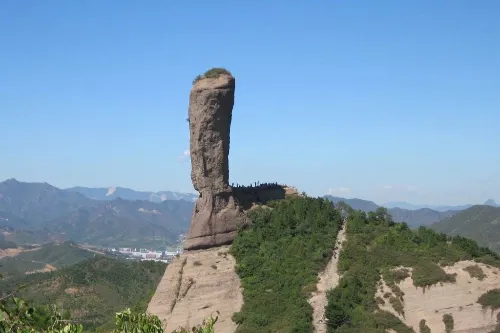
Hama Stone (Toad Stone)
Hama Stone is located about 500 meters southeast of Qingchui Peak. It is a huge stone shaped like a squatting frog, belonging to the granite landform. The stone is about 20 meters long, 14 meters high and 16 meters wide, with a lifelike shape. It echoes with Qingchui Peak from a distance, forming a natural picture. Hama Stone was also formed by geological processes, and its surface is covered with weathering traces, witnessing the changes of years. It is another distinctive natural landscape in the scenic area.
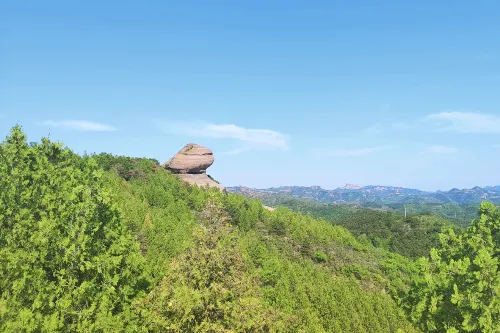
Baoshan Temple
Baoshan Temple is located at the southern foot of Qingchui Peak. It was built in the Qing Dynasty and is a temple with typical Qing Dynasty architectural style. The temple faces east with its back to the west, leaning against the natural stone wall formed by Danxia landform. The main body of the building is of brick and gray tile hard mountain wall structure, with a narrow overall space consisting of only one courtyard and one gate. There are seven cliff carved statues preserved in the temple.
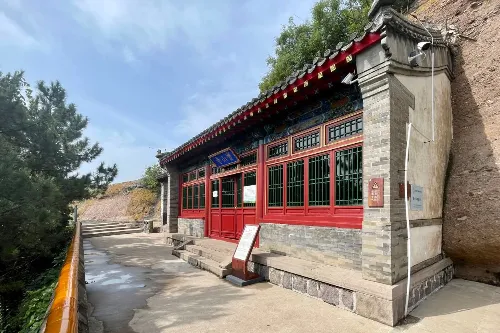
Anyuan Temple
Anyuan Temple is located near Qingchui Peak National Forest Park. It is one of the Eight Outer Temples of the Qing Dynasty and was built in the 29th year of Emperor Qianlong's reign (1764). The temple covers an area of about 26,000 square meters, and its main building is Pudu Hall. Its architectural style combines the characteristics of the Han and Tibetan nationalities, with unique artistic value. The construction of Anyuan Temple is related to the national policies and military activities at that time, and it is an important example for studying the ethnic relations and architectural art of the Qing Dynasty. At present, it is also one of the important cultural attractions in the scenic area.
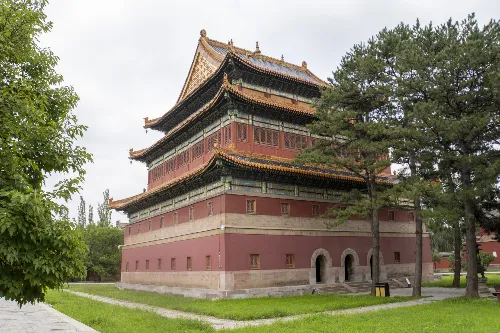
Pule Temple
Pule Temple is located near Qingchui Peak National Forest Park and was built in the 31st year of the Qianlong reign (1766). The temple gate faces west, covering an area of 24,000 square meters. Its architecture is a combination of Han and Tibetan styles: the western part adopts the "Seven Halls of Garan" layout in Han style, while the eastern part is a Tibetan-style "Duocheng" (a multi-tiered, fortress-like temple structure unique to Tibetan Buddhism). The main building, Xuguang Pavilion, features a double-eaved round roof, similar to the Hall of Prayer for Good Harvests in Beijing's Temple of Heaven. Inside the pavilion, there is the largest three-dimensional mandala model in China and a bronze statue of "Shanglè Wangfo" (the Buddha of Supreme Bliss).
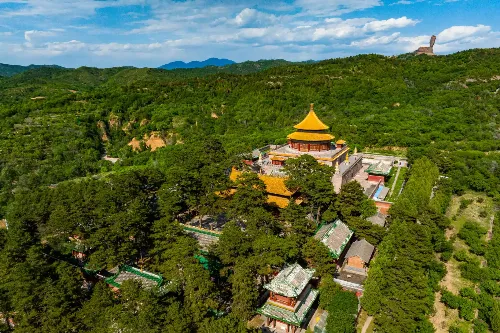
Cableway
The cableway of Qingchui Peak National Forest Park is currently the longest chairlift cableway in China. It has a total length of 1,620 meters, with 180 chairs in total. The one-way running time is about 21 minutes, crossing two beams and two valleys. Taking this cableway, you can reach the foot of the mountain from the scenic area gate, and then it takes about 20 minutes to climb to the mountain along the stone steps, allowing tourists to enjoy the beautiful scenery along the way while saving energy.
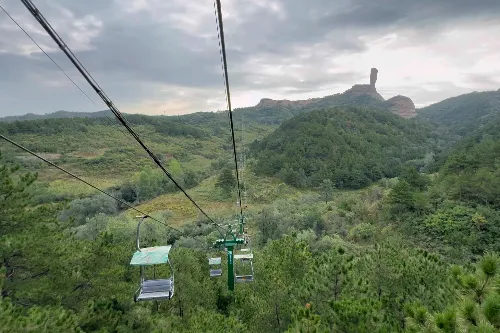
Tour Route
Tourists can enter from the main gate of the scenic area and first go to the Qingchui Peak Scenic Area. Climb up along the hiking trail, which is about 3 kilometers long. Along the way, you can enjoy the mountain forest scenery. It takes about 1.5 hours to reach the viewing platform of Qingchui Peak and watch the majestic appearance of Qingchui Peak at close range. Then return to the middle of the mountain along the original road and turn to Hama Stone scenic spot, which is about 1 kilometer away and takes about 30 minutes on foot to reach. After enjoying Hama Stone, go to Baoshan Temple, which is about 1.5 kilometers away and takes about 40 minutes on foot. Visit Baoshan Temple for about 1 hour. Then go to Anyuan Temple, which is about 2 kilometers away. You can choose to take the scenic area sightseeing bus (about 15 minutes by car) or walk (about 1 hour), and visit Anyuan Temple for about 1.5 hours. The entire route is about 8 kilometers long, and the tour time is about 6-7 hours, allowing you to fully appreciate the natural and cultural landscapes of the scenic area.
Travel Suggestions
- It is recommended to spend 1-2 days here. If you have enough time, you can have an in-depth experience of the natural and cultural landscapes of the scenic area.
- Prepare comfortable sports shoes before climbing, because most of the scenic area are hiking trails, and the total walking distance is long, about 8-10 kilometers.
- Take sun protection measures when visiting in summer, such as carrying a sun hat and sunscreen. At the same time, prepare enough drinking water, as there are few water refill points in some areas of the scenic area.
- The temperature is low in spring and autumn, especially with a large temperature difference between morning and evening. It is recommended to carry warm clothes to avoid catching cold.
- It is recommended to carry light food such as bread and fruits. There are few catering points in the scenic area and the prices are relatively high, so you can replenish energy during the climb.
- If you are interested in history and culture, you can hire a scenic area guide or rent an electronic interpreter to learn more about the historical stories behind the scenic spots. The rent of the interpreter is about 20 yuan per unit.
- The best time to visit is from April to October, when the climate is pleasant and the scenery is beautiful. Among them, in autumn (September-October), the mountains are covered with colorful leaves, and the scenery is particularly charming.
Matters Needing Attention
- Smoking and using open flames are strictly prohibited in the scenic area, and flammable and explosive items are strictly prohibited from entering to protect the safety of forest resources.
- During the climb, you must abide by the regulations of the scenic area, and must not leave the designated trails without permission or enter undeveloped areas to prevent danger.
- Take good care of the environment of the scenic area, do not litter, and put waste into designated trash cans.
- Respect religious beliefs and local customs, keep quiet in religious places such as temples, and do not touch cultural relics and religious facilities at will.
- Some sections in the scenic area are relatively steep. The elderly, children and the weak need to be accompanied by their families when visiting, and pay attention to safety.
- Take good care of your personal belongings. When there are many tourists in the scenic area, pay attention to preventing theft.
- In case of bad weather (such as heavy rain, thunder and lightning), you should take shelter in the designated safe areas of the scenic area in time, follow the instructions of the staff, and do not continue climbing.
Transportation
- Bus: Take bus No. 10 or 28 in Chengde to directly reach the gate of Qingchui Peak National Forest Park. The journey takes about 30 minutes, and the fare is 2 yuan per person.
- Taxi: Take a taxi from Chengde Mountain Resort to the scenic area, which is about 5 kilometers away. The journey takes about 15 minutes, and the cost is about 15-20 yuan.
- Self-driving: Starting from Chengde urban area, drive east along Pule Road and turn into Qingchuifeng Road to reach the scenic area parking lot. The parking fee is 5 yuan per hour.
- Tourist special line: Chengde Tourist Distribution Center has a direct tourist special line to the scenic area, departing at 8:00 and 9:00 every morning, and returning at 16:00 and 17:00 in the afternoon. The round-trip fare is 30 yuan per person.
Opening Hours
The opening hours are adjusted according to the season. In the peak season (April 1 - October 31), the opening hours are 7:30-18:00, and the last entry time is 16:30; in the off-season (November 1 - March 31 of the next year), the opening hours are 8:00-17:00, and the last entry time is 15:30. The opening hours of each attraction in the scenic area are the same as those of the park. In case of special weather or major events, the opening hours may be adjusted. It is recommended to check the official announcement of the scenic area before traveling.
Tickets
As of August 17, 2025, the ticket price is 50 yuan per person (including Pule Temple and Anyuan Temple). You can search for the official WeChat public account "避暑山庄及周围寺庙" to buy tickets online.
Online Booking
Click here to jump to the Trip.com ticketing platform for ticket purchase.
